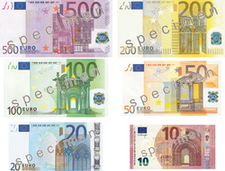Euro
From Wikipedia, the free encyclopedia
유로(통화 기호: €; 코드: EUR)는 유럽 연합(EU)의 공식 통화이다. 유로는 19개국의 유럽 연합 가입국과 유럽 연합에 가입하지 않은 9개국에서 사용되며, 이들 국가를 통틀어 유로존이라고 한다. 2008년 11월 기점으로 하여 실거래에 운용되고 있는 유로화는 약 7510억 유로(당시 9530억 미국 달러 정도)로 알려져 있으며 전 세계적으로 화폐 자체적인 가치와 기타 가치를 더한 실질적인 화폐 가치는 미국 달러를 앞지르고 있다.
3억 3,200만 명의 유럽인들에게 사용되며 전 세계적으로는 1억 7,500만 명에 해당하는 인구수가 자국의 화폐단위를 유로에 고정하고 있다. 이 중, 1억 5,000만 명 정도는 아프리카 거주 인구이다. 국제통화기금의 발표치에 따르면 유로존은 세계 경제에서 두 번째로 높은 구매력을 보유하고 있다.
유로는 1999년 1월 1일 결제를 위한 가상 화폐로 처음 알려졌다. 한동안 현금 유로는 없었으나 2002년 1월 1일부터 법정 통화가 되며 정식으로 동전과 지폐가 발행되기 시작하였다. 유로는 예전의 유럽 통화 단위(ECU)를 1:1 비율로 대체하였다.
2009년 말부터 여러 유럽 국가들의 재정 위기 압박이 거세지면서 국채가 높은 상위 3개국의 등급을 하향조정하고 유럽경제안정위원회가 창설되게 되었다.

The euro (sign: €; code: EUR) is the official currency of the eurozone, which consists of 19 of the 28 member states of the European Union: Austria, Belgium, Cyprus, Estonia, Finland, France, Germany, Greece, Ireland, Italy, Latvia, Lithuania, Luxembourg, Malta, the Netherlands, Portugal, Slovakia, Slovenia, and Spain. The currency is also officially used by the institutions of the European Union and four other European countries, as well as unilaterally by two others, and is consequently used daily by some 334 million Europeans as of 2013. Outside of Europe, a number of overseas territories of EU members also use the euro as their currency.
Additionally, 210 million people worldwide as of 2013—including 182 million people in Africa—use currencies pegged to the euro. The euro is the second largest reserve currency as well as the second most traded currency in the world after the United States dollar. As of August 2014, with more than €995 billion in circulation, the euro has the highest combined value of banknotes and coins in circulation in the world, having surpassed the U.S. dollar.[note 17] Based on International Monetary Fund estimates of 2008 GDP and purchasing power parity among the various currencies, the eurozone is the second largest economy in the world.
The name euro was officially adopted on 16 December 1995. The euro was introduced to world financial markets as an accounting currency on 1 January 1999, replacing the former European Currency Unit (ECU) at a ratio of 1:1 (US$1.1743). Physical euro coins and banknotes entered into circulation on 1 January 2002, making it the day-to-day operating currency of its original members. While the euro dropped subsequently to US$0.8252 within two years (26 October 2000), it has traded above the U.S. dollar since the end of 2002, peaking at US$1.6038 on 18 July 2008. Since late 2009, the euro has been immersed in the European sovereign-debt crisis which has led to the creation of the European Financial Stability Facility as well as other reforms aimed at stabilising the currency. In July 2012, the euro fell below US$1.21 for the first time in two years, following concerns raised over Greek debt and Spain's troubled banking sector. As of January 2015, the euro–dollar exchange rate stands at ~ US$1.15.